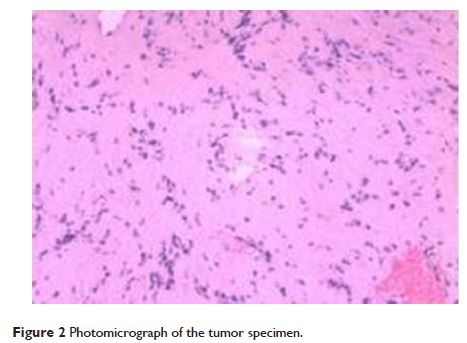109669
论文已发表
注册即可获取德孚的最新动态
IF 收录期刊
- 3.4 Breast Cancer (Dove Med Press)
- 3.2 Clin Epidemiol
- 2.6 Cancer Manag Res
- 2.9 Infect Drug Resist
- 3.7 Clin Interv Aging
- 5.1 Drug Des Dev Ther
- 3.1 Int J Chronic Obstr
- 6.6 Int J Nanomed
- 2.6 Int J Women's Health
- 2.9 Neuropsych Dis Treat
- 2.8 OncoTargets Ther
- 2.0 Patient Prefer Adher
- 2.2 Ther Clin Risk Manag
- 2.5 J Pain Res
- 3.0 Diabet Metab Synd Ob
- 3.2 Psychol Res Behav Ma
- 3.4 Nat Sci Sleep
- 1.8 Pharmgenomics Pers Med
- 2.0 Risk Manag Healthc Policy
- 4.1 J Inflamm Res
- 2.0 Int J Gen Med
- 3.4 J Hepatocell Carcinoma
- 3.0 J Asthma Allergy
- 2.2 Clin Cosmet Investig Dermatol
- 2.4 J Multidiscip Healthc

神经鞘瘤切除后的弥漫性脑血管痉挛:病例报告
Authors Qi J,Zhang LW, Jia W, Zhang JT, Wu Z
Published Date February 2015 Volume 2015:11 Pages 317—320
DOI http://dx.doi.org/10.2147/NDT.S73333
Received 27 August 2014, Accepted 2 December 2014, Published 5 February 2015
Background: The
etiology of vasospasm after brain tumor resection remains unclear. This is the
first report of diffuse cerebral vasospasm following resection of a schwannoma
located in the left portion/part of the ventral medulla oblongata.
Case presentation: A
16-year-old boy presented with dizziness and projectile vomiting without
apparent cause three months before admission. Magnetic resonance imaging
revealed a space-occupying lesion in the left portion of the ventral medulla
oblongata. The tumor was completely resected. Pathological examination was
consistent with diagnosis of schwannoma. Three days after surgery, the patient
was in an unconscious state. Magnetic resonance angiography revealed the
occurrence of cerebral vasospasm, with ischemic infarction and segmental
cerebrovascular stenosis. Seven days after surgery, dehydration therapy was
carried out and decompressive craniectomy was performed in the frontal and
temporal areas. Despite treatments, the patient was in a persistent vegetative
state after surgery, with normal vital signs.
Conclusion: This was an
uncommon occurrence of diffuse cerebral vasospasm following the resection of
schwannoma. Appropriate management of this condition is uncertain, but
aggressive treatments including expansion of blood volume and relief of spasm
should be performed to treat postsurgery vasospasm.
Keywords: vasospasm, cerebral
tumor resection, schwannoma, decompressive craniectomy, magnetic resonance
angiography
